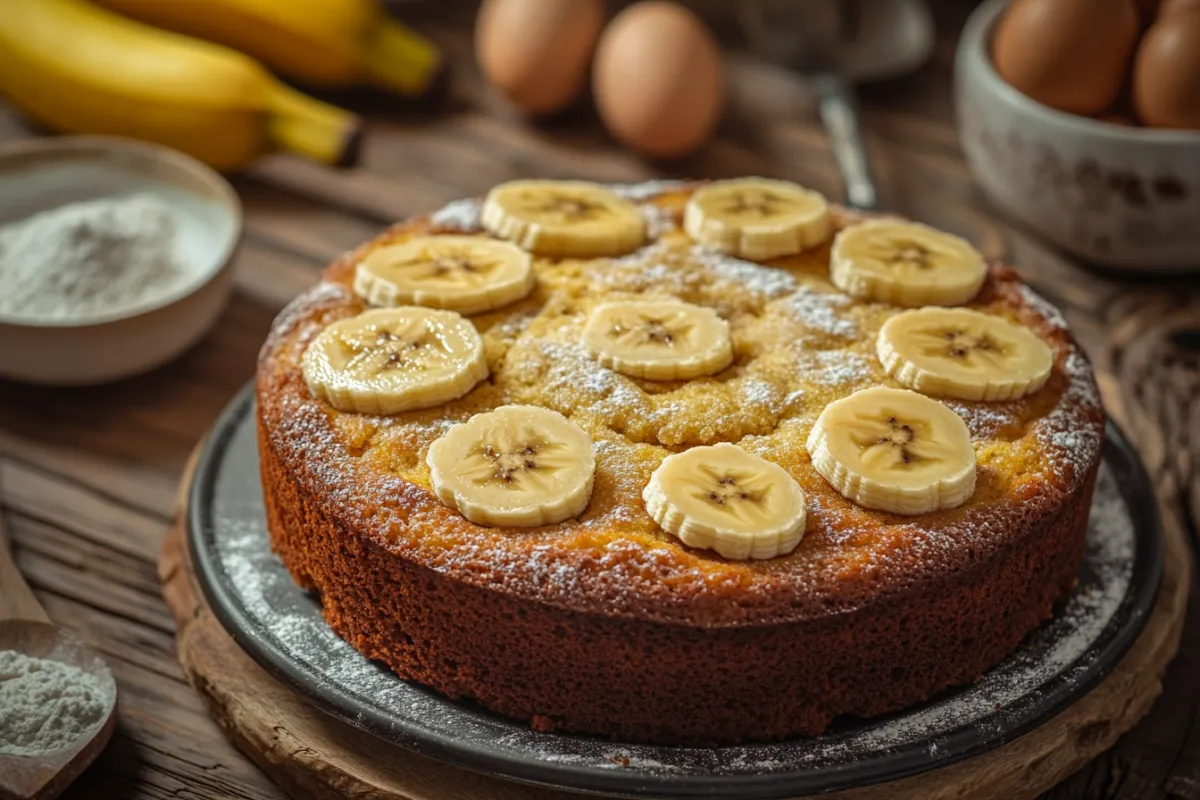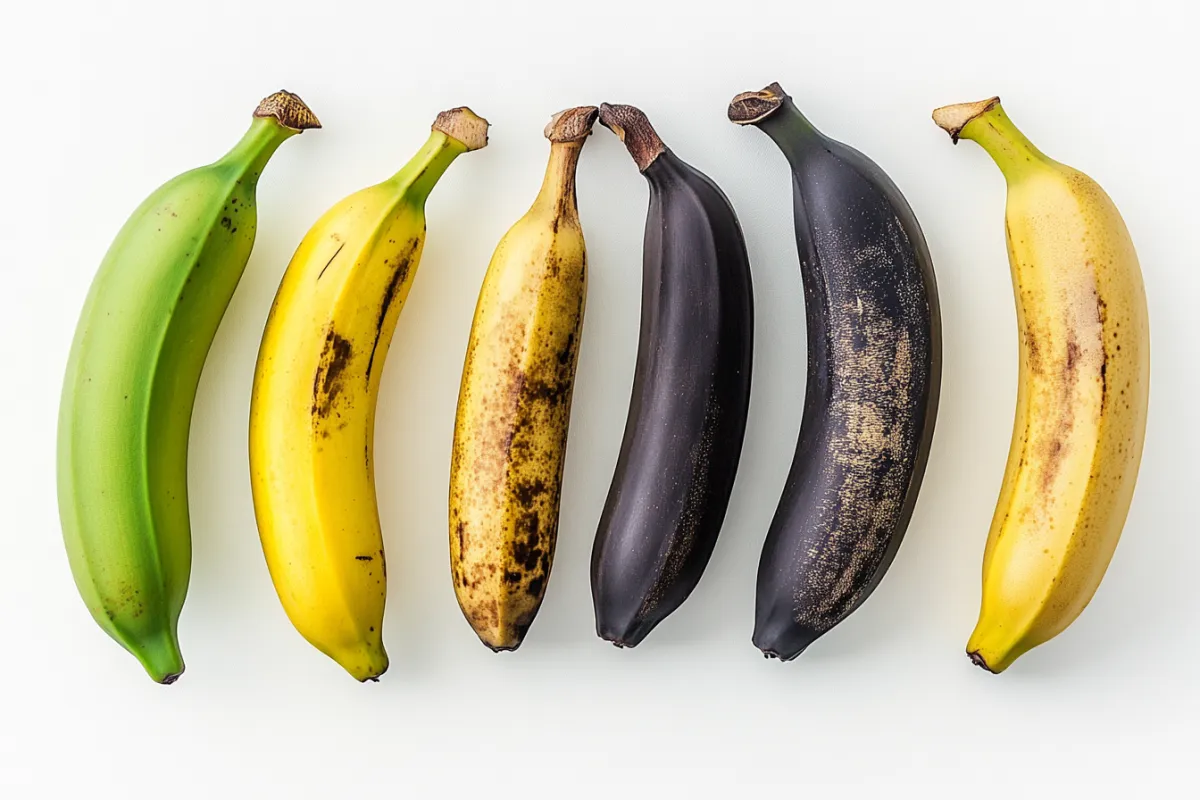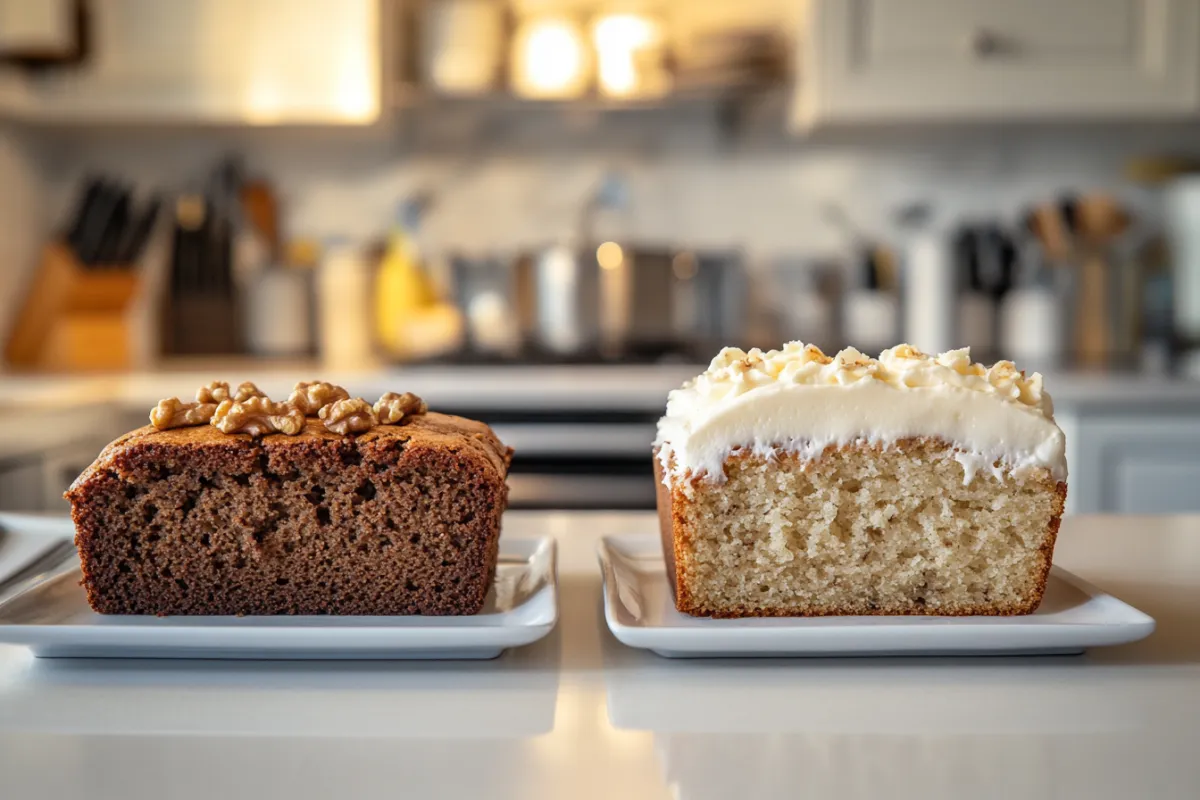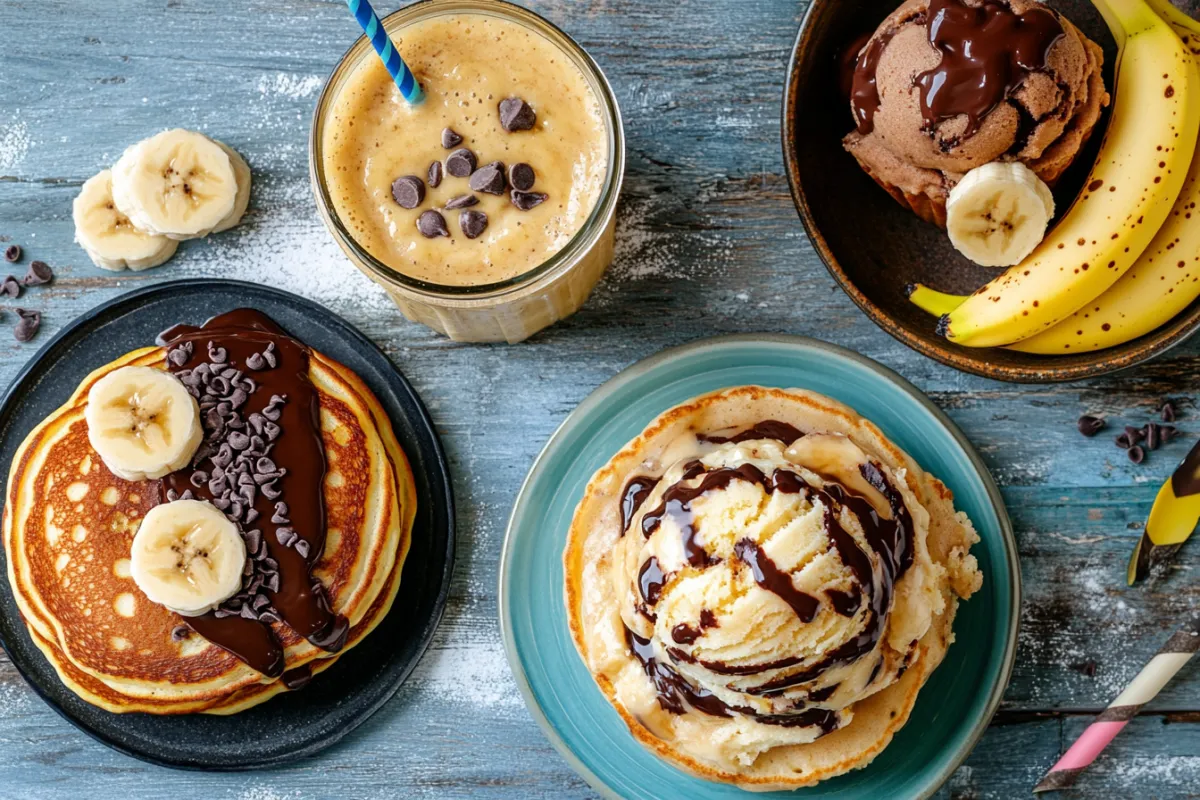Table of Contents:
- Introduction
- The Ripening Process of Bananas
- What Happens as Bananas Ripen?
- The Different Stages of Banana Ripeness
- Green Bananas (Unripe)
- Yellow Bananas with Green Tints (Slightly Unripe)
- Fully Yellow Bananas (Ripe)
- Yellow Bananas with Brown Spots (Fully Ripe)
- Mostly Brown or Black Bananas (Overripe)
- Can Bananas Be Too Ripe for Banana Cake?
- When Are Bananas Too Ripe?
- How Overripe Bananas Enhance Banana Cake
- Banana Bread vs. Banana Cake: What’s the Difference?
- Texture
- Sweetness
- Banana Ripeness
- Factors to Consider When Using Overripe Bananas
- Texture of the Bananas
- Flavor Intensity
- Moisture Balance
- How to Ripen Bananas Quickly for Baking
- The Paper Bag Method
- The Oven Method
- Creative Uses for Overripe Bananas
- Banana Pancakes
- Banana Muffins
- Banana Smoothies
- Banana Ice Cream
- Banana Bread Pudding
- FAQs
- Can Bananas Be Too Overripe for Banana Cake?
- Can I Use Bananas with Black Peels for Baking?
- What If My Bananas Are Too Green?
- What’s the Difference Between Banana Bread and Banana Cake in Terms of Ripeness?
- Conclusion
Introduction:
Bananas are one of the most versatile and beloved fruits, especially in the world of baking. While they can be enjoyed fresh as a snack or added to smoothies and desserts, they truly shine in baked goods such as banana bread and banana cake. As bananas ripen, they become softer, sweeter, and more aromatic, making them ideal for use in these types of recipes. But a common question arises in many kitchens: Can bananas be too old for banana cake?
In this comprehensive guide, we will explore the different stages of banana ripeness, determine when bananas are past their prime for baking, and share tips on how to make the most of overripe bananas. Whether you’re an experienced baker or a beginner, this article will answer all your questions and help you make the perfect banana cake.
The Ripening Process of Bananas:
To determine if bananas are too old for banana cake, we need to understand the ripening process and how bananas change as they age. Bananas go through several stages of ripeness, from green and firm to yellow and spotted, and finally to brown or black. Each stage of ripeness has a significant impact on the flavor, texture, and overall quality of the bananas when used in baking.
What Happens as Bananas Ripen?
Bananas undergo several biological changes as they ripen. The main processes include:
- Starch Conversion to Sugar: Green bananas are high in starch, which is why they taste bland and lack sweetness. As bananas ripen, enzymes break down the starch into simple sugars like glucose and fructose, making the bananas sweeter and softer.
- Cell Wall Breakdown: Bananas soften as they ripen because their cell walls start to break down. This process makes ripe bananas easier to mash and incorporate into batter, contributing to a tender and moist cake.
- Color Change: The color of the banana peel is a clear indicator of its ripeness. Green bananas are unripe, while yellow bananas with brown spots are ripe. As the ripening process continues, the peel turns brown or black, signaling that the bananas have reached their peak ripeness.
- Aroma Development: Ripe bananas emit a sweet, fruity aroma due to the release of volatile compounds. This fragrance becomes stronger as the bananas ripen, signaling that they are ready to be used in baking.
The Different Stages of Banana Ripeness:
The ripeness of bananas has a direct impact on the flavor and texture of your banana cake. Here’s a closer look at the different stages of ripeness:
1. Green Bananas (Unripe):
- Texture: Firm and starchy.
- Flavor: Mild, with little to no sweetness.
- Best Use: Green bananas are not suitable for banana cake because they lack the natural sweetness and softness needed for a good texture. However, green bananas can be used in savory dishes like tostones or as a thickener in soups and stews.
2. Yellow Bananas with Green Tints (Slightly Unripe):
- Texture: Slightly firm, with a hint of softness.
- Flavor: Mild sweetness, with some starchiness remaining.
- Best Use: These bananas can be used in banana cake, but they are not ideal. The cake may turn out denser, and the banana flavor will be less pronounced. If you have only slightly unripe bananas, you can add extra sweeteners like honey or maple syrup to enhance the flavor.
3. Fully Yellow Bananas (Ripe):
- Texture: Soft and creamy.
- Flavor: Balanced sweetness with a mild banana flavor.
- Best Use: Fully yellow bananas are good for banana cake, as they provide a pleasant flavor and texture. However, for the best results, wait until the bananas develop brown spots.
4. Yellow Bananas with Brown Spots (Fully Ripe):
- Texture: Very soft and easy to mash.
- Flavor: Sweet, with a rich banana flavor.
- Best Use: Bananas with brown spots are ideal for banana cake. The spots indicate that the bananas are at their peak ripeness, offering the perfect combination of sweetness and moisture. These bananas will make your cake soft, tender, and flavorful.
5. Mostly Brown or Black Bananas (Overripe):
- Texture: Extremely soft, almost mushy.
- Flavor: Very sweet, with a strong banana flavor.
- Best Use: Brown or black bananas are excellent for banana cake. While they may look unappealing, their high sugar content and softness make them perfect for baking. Overripe bananas add a depth of flavor and ensure that the cake is moist and rich.
Can Bananas Be Too Ripe for Banana Cake?
Bananas are rarely too ripe for banana cake. In fact, the riper the banana, the better it is for baking. Overripe bananas that have turned black on the outside are often considered the best for banana-based recipes like banana cake, as they are sweeter and softer. However, there is a limit to how ripe bananas can be before they are no longer suitable for baking.
When Are Bananas Too Ripe?
While overripe bananas are generally perfect for banana cake, there are a few signs that indicate bananas are too far gone to use:
- Mold Growth: If there is visible mold on the banana peel or near the stem, the bananas should not be used. Mold can be harmful to consume, and even a small amount on the peel can indicate that the fruit has spoiled.
- Fermented Smell: Overripe bananas should have a sweet, pleasant aroma. If your bananas emit a sour or fermented odor, similar to vinegar or alcohol, they are no longer good for baking and should be discarded.
- Slimy Texture: While overripe bananas are soft and mushy, they should not be slimy. A slimy texture indicates that the bananas have started to decompose, and they may affect the flavor and texture of your cake negatively.
How Overripe Bananas Enhance Banana Cake:
If your bananas are very ripe but not spoiled, they will provide several benefits when used in banana cake:
- Added Sweetness: Overripe bananas have a high sugar content, which adds natural sweetness to your cake. You may even be able to reduce the amount of added sugar in the recipe when using very ripe bananas.
- Increased Moisture: The softness of overripe bananas contributes moisture to the cake batter, resulting in a tender, moist cake with a soft crumb.
- Enhanced Banana Flavor: Overripe bananas have a more intense banana flavor than less ripe bananas. This concentrated flavor will come through in your cake, making it more flavorful and aromatic.
Banana Bread vs. Banana Cake: What’s the Difference?
Banana bread and banana cake are often used interchangeably, but they are quite different in terms of texture, sweetness, and the type of bananas that work best for each. Understanding the differences can help you decide which recipe to make based on the ripeness of your bananas.
Banana Bread:
- Texture: Banana bread is dense, hearty, and often includes nuts or chocolate chips for added texture.
- Sweetness: Banana bread is usually less sweet than banana cake and may contain whole grains or other ingredients that contribute to its rustic flavor.
- Banana Ripeness: For banana bread, bananas that are slightly overripe with brown spots are ideal. These bananas provide sweetness and moisture without making the bread too dense or soggy.
Banana Cake:
- Texture: Banana cake is lighter, fluffier, and more cake-like in texture. It often includes additional ingredients like vanilla extract, baking powder, and even cream cheese frosting to enhance its dessert-like qualities.
- Sweetness: Banana cake is sweeter than banana bread, making it a more indulgent treat. The use of overripe bananas enhances the cake’s natural sweetness.
- Banana Ripeness: For banana cake, the best bananas are those that are very ripe or blackened. These bananas add extra moisture and flavor to the cake, resulting in a soft and tender crumb.
For more banana-based inspiration, check out this recipe for banana walnut cake that uses overripe bananas for an extra flavorful result.
Factors to Consider When Using Overripe Bananas:
When using overripe bananas in banana cake, there are a few key factors to keep in mind to ensure the best results:
Texture of the Bananas:
Overripe bananas can sometimes make the batter too wet, especially if they are extremely soft and mushy. If this happens, consider adjusting the other ingredients in your recipe to compensate for the added moisture:
- Reduce the Liquid Ingredients: Cut back on the amount of milk, oil, or water in your recipe to balance the moisture from the bananas.
- Increase the Dry Ingredients: Add a little extra flour to absorb the moisture and ensure the cake has the proper structure. Be careful not to add too much, as this can make the cake dense and heavy.
Flavor Intensity:
Overripe bananas have a strong banana flavor, which can dominate the other flavors in the cake. If you prefer a more balanced taste, you can:
- Use Bananas with Brown Spots: Instead of using blackened bananas, opt for bananas that are yellow with brown spots. These bananas are still sweet and flavorful, but their taste is less overpowering.
- Enhance with Spices: Add spices like cinnamon, nutmeg, or ginger to complement the banana flavor and create a more complex taste profile.
Moisture Balance:
The moisture content in overripe bananas is one of their greatest assets in baking, but too much moisture can lead to a soggy cake. To prevent this, ensure your cake is baked thoroughly and for the correct amount of time:
- Test for Doneness: Use a toothpick or cake tester to check if the cake is fully baked. If the tester comes out clean, the cake is ready to be removed from the oven. If it comes out with wet batter, continue baking in 5-minute intervals.
- Cool the Cake Properly: Let the cake cool completely on a wire rack before slicing. This allows the moisture to redistribute throughout the cake, resulting in a soft, tender crumb.
How to Ripen Bananas Quickly for Baking:
What if you don’t have overripe bananas on hand but want to bake a banana cake right away? Fortunately, there are a few simple methods to speed up the ripening process:
The Paper Bag Method:
Bananas naturally produce ethylene gas, which accelerates ripening. By placing your bananas in a paper bag, you can trap the gas and encourage faster ripening.
- Instructions:
- Place the bananas in a brown paper bag.
- Fold the top of the bag to seal in the ethylene gas.
- Leave the bag at room temperature for 1-2 days, checking periodically to see if the bananas have ripened.
For faster results, add an apple or avocado to the bag, as these fruits also release ethylene gas and will help speed up the ripening process.
The Oven Method:
If you need ripe bananas immediately, the oven method is a quick and easy solution. This method softens the bananas and brings out their sweetness, making them perfect for banana cake.
- Instructions:
- Preheat your oven to 300°F (150°C).
- Place the unpeeled bananas on a baking sheet lined with parchment paper.
- Bake the bananas for 15-20 minutes or until the peels turn black and the fruit is soft.
- Let the bananas cool before using them in your recipe.
Creative Uses for Overripe Bananas:
Banana cake isn’t the only way to use up overripe bananas. Here are some other creative and delicious ways to make the most of bananas that have passed their prime:
Banana Pancakes:
Overripe bananas are perfect for making banana pancakes. Simply mash the bananas and mix them into your pancake batter for a naturally sweet, moist breakfast. You can also add a handful of chocolate chips or a sprinkle of cinnamon for extra flavor.
- Recipe Idea: Combine mashed bananas with eggs, flour, baking powder, and a dash of vanilla extract. Cook the pancakes on a griddle until golden brown, then top with maple syrup and fresh fruit.
Banana Muffins:
Similar to banana cake, banana muffins are a great way to use overripe bananas. These portable treats are perfect for breakfast or an afternoon snack.
- Recipe Idea: Add walnuts, pecans, or chocolate chips to your banana muffin batter for extra texture and flavor. You can also sprinkle the tops with a little cinnamon sugar before baking for a crunchy finish.
Banana Smoothies:
Frozen overripe bananas are the secret to a creamy, naturally sweet smoothie. Peel and freeze bananas when they’re too ripe to eat fresh, and use them as a base for smoothies.
- Recipe Idea: Blend frozen bananas with almond milk, spinach, and a spoonful of peanut butter for a nutrient-packed breakfast or post-workout snack.
Banana Ice Cream:
You can make banana ice cream using only one ingredient: overripe bananas! Known as “nice cream,” this dairy-free dessert is made by blending frozen bananas until they reach a creamy, ice cream-like consistency.
- Recipe Idea: For extra flavor, add cocoa powder, vanilla extract, or a spoonful of almond butter to your banana ice cream. Top with crushed nuts or fresh berries for a healthy dessert.
Banana Bread Pudding:
If you have leftover banana bread, consider transforming it into a comforting banana bread pudding. Tear the banana bread into chunks and soak it in a custard mixture made of eggs, milk, sugar, and cinnamon. Bake until golden and enjoy as a cozy dessert.
FAQs:
Can Bananas Be Too Overripe for Banana Cake?
Yes, bananas can be too overripe if they show signs of spoilage, such as mold or a sour smell. However, bananas with black peels that are soft and sweet are ideal for banana cake.
Can I Use Bananas with Black Peels for Baking?
Absolutely! Bananas with black peels are perfect for banana cake. They add sweetness, moisture, and a rich banana flavor. Just be sure to avoid any bananas that have gone moldy or slimy.
What If My Bananas Are Too Green?
If your bananas are too green, you can speed up the ripening process using the paper bag or oven methods mentioned earlier. Green bananas are too starchy for banana cake and will not provide the sweetness and moisture needed for a good result.
What’s the Difference Between Banana Bread and Banana Cake in Terms of Ripeness?
Banana bread typically requires slightly less ripe bananas to maintain structure and prevent the bread from becoming too moist. Banana cake, on the other hand, benefits from very ripe bananas, which contribute to a sweeter flavor and softer texture.
Conclusion:
In conclusion, bananas are rarely too old for banana cake unless they show signs of spoilage such as mold or a sour smell. The riper the banana, the better the result, as overripe bananas provide the ideal sweetness, flavor, and moisture for a delicious and moist cake. Whether you’re making banana cake, muffins, or pancakes, overripe bananas are a versatile and valuable ingredient in your kitchen.
For more creative ways to use bananas, don’t miss this banana walnut cake recipe to expand your dessert options.




